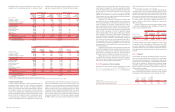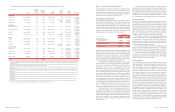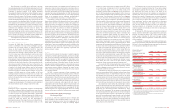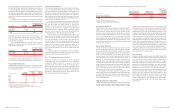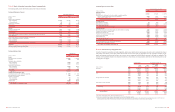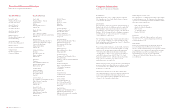Bank of America 2003 Annual Report Download - page 53
Download and view the complete annual report
Please find page 53 of the 2003 Bank of America annual report below. You can navigate through the pages in the report by either clicking on the pages listed below, or by using the keyword search tool below to find specific information within the annual report.
102 BANK OF AMERICA 2003 BANK OF AMERICA 2003 103
Note 16 Employee Benefit Plans
Pension and Postretirement Plans
The Corporation sponsors noncontributory trusteed qualified pension
plans that cover substantially all officers and employees. The plans
provide defined benefits based on an employee’s compensation, age
and years of service. The Bank of America Pension Plan (the Pension
Plan) provides participants with compensation credits, based on age
and years of service. The Pension Plan allows participants to select
from various earnings measures, which are based on the returns of
certain funds or common stock of the Corporation. The participant-
selected earnings measures determine the earnings rate on the indi-
vidual participant account balances in the Pension Plan. Participants
may elect to modify earnings measure allocations on a daily basis.
The benefits become vested upon completion of five years of service.
It is the policy of the Corporation to fund not less than the minimum
funding amount required by ERISA. During 2004, the Corporation will
contribute at least $87 million to the Pension Plan, the Nonqualified
Pension Plans and the Post Retirement Health and Life Plans.
The Pension Plan has a balance guarantee feature, applied at
the time a benefit payment is made from the plan, that protects par-
ticipant balances transferred and certain compensation credits from
future market downturns. The Corporation is responsible for funding
any shortfall on the guarantee feature.
The Corporation sponsors a number of noncontributory, non-
qualified pension plans. These plans, which are unfunded, provide
defined pension benefits to certain employees.
In addition to retirement pension benefits, full-time, salaried
employees and certain part-time employees may become eligible to
continue participation as retirees in health care and/or life insurance
plans sponsored by the Corporation. Based on the other provisions
of the individual plans, certain retirees may also have the cost of
these benefits partially paid by the Corporation.
Reflected in these results are key changes to the Postretirement
Health and Life Plans and the nonqualified pension plans. In 2002, a
one-time curtailment charge resulted from freezing benefits for
supplemental executive retirement agreements. Additionally, on
December 8, 2003, the President signed the Medicare Prescription
Drug, Improvement and Modernization Act of 2003 (the Act) into law.
The Act introduces a voluntary prescription drug benefit under
Medicare as well as a federal subsidy to sponsors of retiree health
care plans that provide at least an actuarially equivalent benefit. As
permitted by FASB Staff Position (FSP) No. FAS 106-1 “Accounting and
Disclosure Requirements Related to the Medicare Prescription Drug,
Improvement and Modernization Act of 2003” (FSP 106-1), the
Corporation has elected to defer recognizing the effects of the Act on
its Postretirement Health and Life Plans. As a result, any measures of
the accumulated projected benefit obligation (APBO) of the
Postretirement Health and Life Plans or the net periodic postretire-
ment benefit cost in the consolidated financial statements do not
reflect the effects of the Act on the Postretirement Health and Life
Plans. Specific authoritative guidance on the accounting for the fed-
eral subsidy is pending and that guidance, when issued, may or may
not require the Corporation to change previously reported information.
The following table summarizes the changes in fair value of plan
assets, changes in the projected benefit obligation (PBO), the funded
status of both the accumulated benefit obligation (ABO), and the PBO
and the weighted average assumptions used to determine benefit
obligations for the pension plans and postretirement plans for 2003
and 2002. Prepaid and accrued benefit costs are reflected in other
assets, and accrued expenses and other liabilities, respectively, on
the Consolidated Balance Sheet. The discount rate assumption is
based on the internal rate of return for a portfolio of high quality
bonds (Moody’s Aa Corporate bonds) with maturities that are consis-
tent with projected future cash flows. For both the Pension Plan and
the Postretirement Health and Life Plans, the discount rate at
December 31, 2003 was 6.25 percent. For both the Pension Plan and
the Postretirement Health and Life Plans, the expected long-term
The following table presents the regulatory risk-based capital ratios, actual capital amounts and minimum required capital amounts for the
Corporation, Bank of America, N.A. and Bank of America, N.A. (USA) at December 31, 2003 and 2002:
December 31
2003 2002
Actual Minimum Actual Minimum
(Dollars in millions)
Ratio Amount Required(1) Ratio Amount Required(1)
Tier 1 Capital
Bank of Ame rica Corporation
7.85% $44,050 $22,452 8.22% $43,012 $20,930
Bank of America, N.A.
8.73 42,030 19,247 8.61 40,072 18,622
Bank of America, N.A. (USA)
8.41 3,079 1,465 8.95 2,346 1,049
Total Capital
Bank of Ame rica Corporation
11.87 66,651 44,904 12.43 65,064 41,860
Bank of America, N.A.
11.31 54,408 38,494 11.40 53,091 37,244
Bank of America, N.A. (USA)
12.29 4,502 2,930 11.97 3,137 2,098
Leverage
Bank of Ame rica Corporation
5.73 44,050 30,741 6.29 43,012 27,335
Bank of America, N.A.
6.88 42,030 24,425 7.02 40,072 22,846
Bank of America, N.A. (USA)
9.17 3,079 1,344 9.58 2,346 980
(1) Dollar amount required to meet guidelines for adequately-capitalized institutions.
Note 15 Regulatory Requirements and Restrictions
The Board of Governors of the Federal Reserve System (FRB) requires
the Corporation’s banking subsidiaries to maintain reserve balances
based on a percentage of certain deposits. Average daily reserve bal-
ances required by the FRB were $4.1 billion and $3.7 billion for 2003
and 2002, respectively. Currency and coin residing in branches and
cash vaults (vault cash) are used to partially satisfy the reserve
requirement. The average daily reserve balances, in excess of vault
cash, held with the Federal Reserve Bank amounted to $317 million
and $95 million for 2003 and 2002, respectively.
The primary source of funds for cash distributions by the
Corporation to its shareholders is dividends received from its bank-
ing subsidiaries. Bank of America, N.A. declared and paid dividends
of $8.1 billion for 2003 to its Parent. In 2004, Bank of America, N.A.
can declare and pay dividends to its Parent in an amount not to
exceed 2004 net income. The other subsidiary national banks can
initiate aggregate dividend payments in 2004 of $1.9 billion plus an
additional amount equal to their net profits for 2004, as defined by
statute, up to the date of any such dividend declaration. The amount
of dividends that each subsidiary bank may declare in a calendar year
without approval by the OCC is the subsidiary bank’s net profits for
that year combined with its net retained profits, as defined, for the
preceding two years.
The FRB, the OCC and the Federal Deposit Insurance
Corporation (collectively, the Agencies) have issued regulatory capital
guidelines for U.S. banking organizations. Failure to meet the capital
requirements can initiate certain mandatory and discretionary
actions by regulators that could have a material effect on the
Corporation’s financial statements. At December 31, 2003 and
2002, the Corporation and Bank of America, N.A. were classified as
well-capitalized under this regulatory framework. There have been no
conditions or events since December 31, 2003 that management
believes have changed either the Corporation’s or Bank of America,
N.A.’s capital classifications.
The regulatory capital guidelines measure capital in relation to
the credit and market risks of both on- and off-balance sheet items
using various risk weights. Under the regulatory capital guidelines,
Total Capital consists of three tiers of capital. Tier 1 Capital includes
common shareholders’ equity, Trust Securities, minority interests and
qualifying preferred stock, less goodwill and other adjustments. Tier
2 Capital consists of preferred stock not qualifying as Tier 1 Capital,
mandatory convertible debt, limited amounts of subordinated debt,
other qualifying term debt, the allowance for credit losses up to 1.25
percent of risk-weighted assets and other adjustments. Tier 3 Capital
includes subordinated debt that is unsecured, fully paid, has an orig-
inal maturity of at least two years, is not redeemable before maturity
without prior approval by the FRB and includes a lock-in clause pre-
cluding payment of either interest or principal if the payment would
cause the issuing bank’s risk-based capital ratio to fall or remain
below the required minimum. Tier 3 Capital can only be used to sat-
isfy the Corporation’s market risk capital requirement and may not be
used to support its credit risk requirement. At December 31, 2003
and 2002, the Corporation had no subordinated debt that qualified
as Tier 3 Capital.
The capital treatment of Trust Securities is currently under review
by the FRB due to the issuing trust companies being deconsolidated
under FIN 46. Depending on the capital treatment resolution, Trust
Securities may no longer qualify for Tier 1 Capital treatment, but
instead would qualify for Tier 2 Capital. On July 2, 2003, the FRB
issued a Supervision and Regulation Letter (the Letter) requiring that
bank holding companies continue to follow the current instructions for
reporting Trust Securities in its regulatory reports. Accordingly, the
Corporation will continue to report Trust Securities in Tier 1 Capital
until further notice from the FRB. On September 2, 2003, the FRB and
other regulatory agencies, issued the Interim Final Capital Rule for
Consolidated Asset-backed Commercial Paper Program Assets (the
Interim Rule). The Interim Rule allows companies to exclude from risk-
weighted assets, the newly consolidated assets of asset-backed com-
mercial paper programs required by FIN 46, when calculating Tier 1
and Total Risk-based Capital ratios through March 31, 2004. As of
December 31, 2003, the Corporation consolidated approximately
$4.3 billion of assets from multi-seller asset-backed commercial
paper conduits, in accordance with FIN 46, as originally issued. See
Notes 1 and 9 of the consolidated financial statements for additional
information on FIN 46.
To meet minimum, adequately-capitalized regulatory require-
ments, an institution must maintain a Tier 1 Capital ratio of four
percent and a Total Capital ratio of eight percent. A well-capitalized
institution must generally maintain capital ratios 100 to 200 bps
higher than the minimum guidelines. The risk-based capital rules
have been further supplemented by a leverage ratio, defined as Tier
1 Capital divided by quarterly average total assets, after certain
adjustments. The leverage ratio guidelines establish a minimum of
100 to 200 bps above three percent. Banking organizations must
maintain a leverage capital ratio of at least five percent to be
classified as well-capitalized. As of December 31, 2003, the Corpo-
ration was classified as well-capitalized for regulatory purposes, the
highest classification.
Net unrealized gains (losses) on available-for-sale debt securities,
net unrealized gains on available-for-sale marketable equity securities
and the net unrealized gains (losses) on derivatives included in share-
holders’ equity at December 31, 2003 and 2002 are excluded from the
calculations of Tier 1 Capital, Total Capital and leverage ratios.







